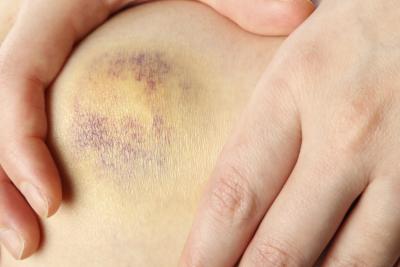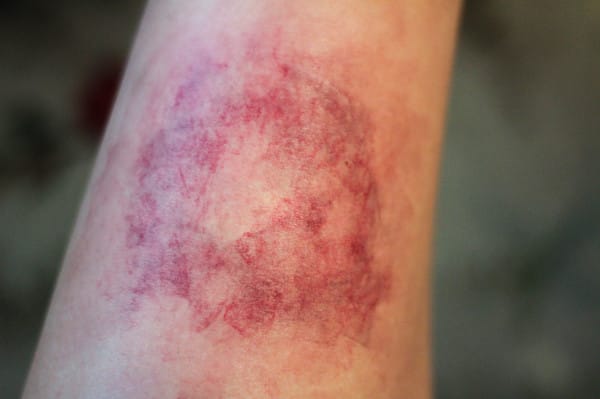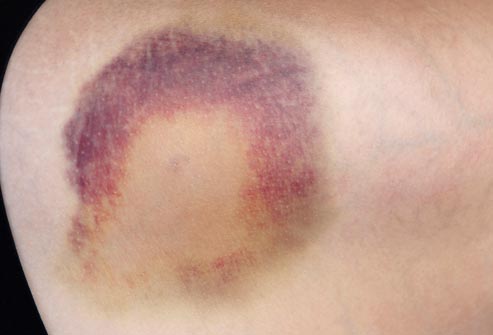Whether you have accidentally hit your funny bone against something or have been in a more serious traumatic accident, you’ve most likely experienced bruising before. Bruises occur when very small blood vessels (capillaries) break because of trauma to the skin. You may wonder: Why are bruises certain colors? Why do bruises turn yellow? This color and appearance change over time is normal, and you can tell how old bruises are according to their color. Usually, skin returns to normal 2-3 weeks post-bruising and injury.
Why Do Bruises Turn Yellow?

If your bruises are yellow, this means that they will soon be completely healed. This final stage of healing is characteristic of the yellow hue. Hemoglobin, a protein containing iron, is released into the body upon the breakdown of red blood cells. This hemoglobin is converted by your body into colored chemicals as your bruises begin to heal, and these chemicals cause the color change. So, why do bruises turn yellow specifically? This is because the final hemoglobin breakdown product is bilirubin, which is yellow. The yellow slowly fades away, leaving your skin healed and normal, as your body clears the last of these chemicals from your blood.
Different Bruise Colors & What They Mean
As mentioned earlier, bruises change color due to the breakdown of hemoglobin that is released into the blood when trauma first happens and capillaries break. We will now discuss the various common bruise colors.



- Red: This is commonly the initial bruise color, especially if the bruise occurs very near the skin’s surface. This is the color of your tissues being flooded with fresh blood – bright red, from both oxygen and iron – leaking into it.
- Blue: Some hours after the initial bruising, blood that leaked from broken capillaries loses its oxygen. This causes the blood to darken and bruise appearance to be purple or blue in hue.
- Purple: Normally, after 1-3 days (varies according to injury severity), bruises can become darker purple and sometimes black. This happens due to the complete breakdown of blood cells and release of iron.
- Green: This is the first sign of your bruises healing (purple to green transformation). When hemoglobin breaks down to biliverdin, green color results – “verdin” comes from the Latin term for “green!”
What If Bruises Don't Go Away?
Why do bruises turn yellow? Because it's healing. However, sometimes bruises don’t heal completely, and the bruised area may become firmer, larger, and more painful. If this happens, it may be due to one of two most common causes:
- A hematoma may have formed to wall off blood still under the skin or muscle, instead of the normal body process of clearing it way;
- The body may have deposited calcium in the area of the injury, in a process called “myositis ossificans” or “heterotopic ossification.”
The former reason simply requires a draining, but the latter reason is more serious and less common and must be diagnosed with an x-ray.
Ways to Heal a Bruise More Quickly
Now that we have learned about different colors of bruises and answered the question “Why do bruises turn yellow?” we will discuss ways to support bruise healing.
1. Speeding Up Color Change and Paling

- Apply ice to the injured site – a cold compress, like wrapped frozen vegetables – to prevent excessive blood leakage to the surrounding tissue.
- Wrap an elastic bandage around the injured area to squeeze the blood vessels under the skin and prevent blood vessel leakage.
- Reduce blood flow to the bruised area. For example, if your leg is bruised, prop it up above heart level.
- An alternative way to prevent discoloration is to apply a warm compress, such as a hot water bottle, over or under the injured area.
2. Try Home Remedies

- Vinegar + water: Mix these together and rub over the bruised site. Vinegar increases blood flow towards the skin surface, expediting the healing process.
- Vitamin C: Mangoes, oranges, broccoli, sweet potatoes, and peppers are rich in vitamin C. You may also crush some vitamin C pills and mix them with water to make a paste and rub it on the affected area.
- Parsley & Ginger: Rubbing crushed parsley onto the bruise or eating fresh ginger may help, as both of these foods have anti-inflammatory qualities.
- Massage: Rub and massage the injured area daily to stimulate blood flow.
- Arnica: This is an inflammation-reducing herb that helps pale bruises quickly. There are arnica gels or creams available at many drug stores. Apply arnica to the bruised site twice daily until the bruise is gone.
